当警觉消失时昏昏欲睡诱发的视觉优势和视听整合中的振荡重新校准。
IF 2.6
3区 心理学
Q3 NEUROSCIENCES
引用次数: 0
摘要
多感觉整合允许大脑调整来自不同感觉模式的输入,增强感知和行为。然而,过渡到困倦状态,以注意力控制下降和皮层动力学改变为特征,为研究这些多感觉过程的适应提供了一个独特的机会。在这项研究中,我们研究了嗜睡如何影响视听多感觉整合过程中的反应时间(RTs)和神经振荡。参与者执行一项任务,其中听觉和视觉刺激要么以协调的方式呈现,要么以时间错位的方式呈现(视觉优先或听觉优先的不协调条件)。行为结果显示,困倦总体上减缓了RTs,但显示出明显的感觉优势效应:与听觉优先的不协调相比,视觉优先的不协调促进了RTs,反映了视觉在重新校准感觉冲突中的主导作用。相比之下,协调条件下的RTs在清醒和困倦状态下保持稳定,这表明多感觉冗余补偿了困倦期间皮层整合的减少。在神经层面,出现了不同的振荡活动模式。在视觉优先的条件下,α振荡支持注意调整和时间调整,而在听觉优先的不协调条件下,伽马振荡被吸收,反映了更高的感觉特异性加工需求。这些影响是状态依赖的,在困倦时更加明显。我们的研究结果表明,困倦通过放大感觉优势机制,特别是视觉,从根本上重塑了多感觉整合。包括α和γ振荡的代偿性神经机制在皮层相互作用减少的条件下维持知觉一致性。这些结果为大脑如何在意识下降的状态下适应感官冲突提供了重要的见解,对现实世界中困倦状态下的表现和决策具有更广泛的影响。本文章由计算机程序翻译,如有差异,请以英文原文为准。
When alertness fades: Drowsiness-induced visual dominance and oscillatory recalibration in audiovisual integration
Multisensory integration allows the brain to align inputs from different sensory modalities, enhancing perception and behavior. However, transitioning into drowsiness, a state marked by decreased attentional control and altered cortical dynamics, offers a unique opportunity to examine adaptations in these multisensory processes. In this study, we investigated how drowsiness influences reaction times (RTs) and neural oscillations during audiovisual multisensory integration. Participants performed a task where auditory and visual stimuli were presented either in a coordinated manner or with temporal misalignment (visual-first or auditory-first uncoordinated conditions).
Behavioral results showed that drowsiness slowed RTs overall but revealed a clear sensory dominance effect: visual-first uncoordination facilitated RTs compared to auditory-first uncoordination, reflecting vision's dominant role in recalibrating sensory conflicts. In contrast, RTs in coordinated conditions remained stable across alert and drowsy states, suggesting that multisensory redundancy compensates for reduced cortical integration during drowsiness.
At the neural level, distinct patterns of oscillatory activity emerged. Alpha oscillations supported attentional realignment and temporal alignment in visual-first conditions, while Gamma oscillations were recruited during auditory-first uncoordination, reflecting heightened sensory-specific processing demands. These effects were state-dependent, becoming more pronounced during drowsiness.
Our findings demonstrate that drowsiness fundamentally reshapes multisensory integration by amplifying sensory dominance mechanisms, particularly vision. Compensatory neural mechanisms involving Alpha and Gamma oscillations maintain perceptual coherence under conditions of reduced cortical interaction. These results provide critical insights into how the brain adapts to sensory conflicts during states of diminished awareness, with broader implications for performance and decision-making in real-world drowsy states.
求助全文
通过发布文献求助,成功后即可免费获取论文全文。
去求助
来源期刊
CiteScore
5.40
自引率
10.00%
发文量
177
审稿时长
3-8 weeks
期刊介绍:
The International Journal of Psychophysiology is the official journal of the International Organization of Psychophysiology, and provides a respected forum for the publication of high quality original contributions on all aspects of psychophysiology. The journal is interdisciplinary and aims to integrate the neurosciences and behavioral sciences. Empirical, theoretical, and review articles are encouraged in the following areas:
• Cerebral psychophysiology: including functional brain mapping and neuroimaging with Event-Related Potentials (ERPs), Positron Emission Tomography (PET), Functional Magnetic Resonance Imaging (fMRI) and Electroencephalographic studies.
• Autonomic functions: including bilateral electrodermal activity, pupillometry and blood volume changes.
• Cardiovascular Psychophysiology:including studies of blood pressure, cardiac functioning and respiration.
• Somatic psychophysiology: including muscle activity, eye movements and eye blinks.

 求助内容:
求助内容: 应助结果提醒方式:
应助结果提醒方式:


